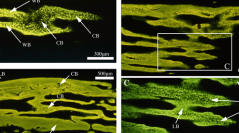

 Comptes Rendus Palevol
15 (1-2) - Pages 49-64
Comptes Rendus Palevol
15 (1-2) - Pages 49-64In histology textbooks, the vertebrate skeleton is represented as almost entirely made of bone and cartilage. This is a false dichotomy and in fact, a continuum of intermediate tissues between bone and cartilage exists. Chondroid bone ([CB] or chondroid tissue), one of the most well-known intermediate tissues, has been reported in mammals, birds and crocodilians. It accommodates (1) rapid growth of the skull and (2) the development of craniofacial sutures. Since CB is present in the extant phylogenetic bracket of the Dinosauria, we hypothesized that it was also present in non-avian dinosaurs. By means of paleohistological examination and microradiography, we report for the first time the presence of CB in non-avian dinosaur embryos and nestlings (Ornithischia: Hadrosauridae). It was found in five locations: (1) scattered within the bone trabeculae of an embryonic surangular; (2) and (3) in the coronoid process and in the alveolar processes of an embryonic dentary; (4) in the mandibular symphyses of an embryonic and a post-hatching dentary; (5) at the fronto-postorbital suture of an embryo. In these areas, CB was present in large amounts, suggesting that it played an important role in the rapid growth of the hadrosaurian skull during embryonic development. Moreover, the CB present in the sutural borders of a Hypacrosaurus frontal suggests that it was also involved in sutural growth, as it has been reported to be in mammalian and avian sutures. This is the first step taken to document and understand dinosaurian sutures from a histological perspective and it sheds light on an old problem by reporting the presence of CB in an additional clade within the Vertebrata. It is parsimonious to propose that CB in the chick embryo, Gallus gallus, the American alligator, Alligator mississippiensis and the hadrosaurs of the present study are homologous and that CB arose once and was inherited from their common ancestor.
Archosauria, Dinosauria, Hadrosauridae, Chondroid bone/tissue, Skull growth, Sutural growth, Evolution of skeletal tissues